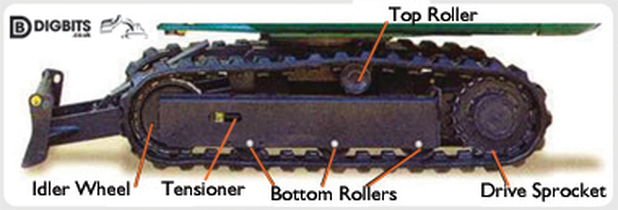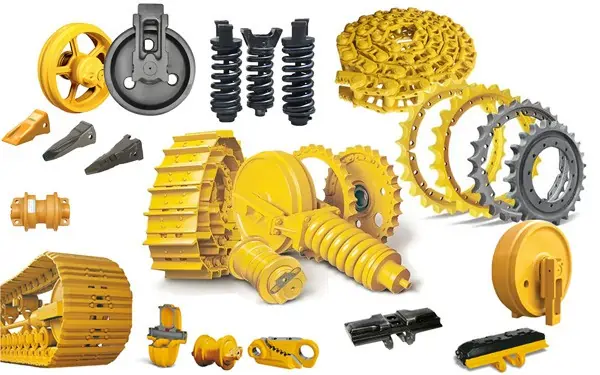From Tracks to Rollers: Exploring High-Quality Undercarriage Parts for Every Requirement
From Tracks to Rollers: Exploring High-Quality Undercarriage Parts for Every Requirement
Blog Article
Key Elements: Undercarriage Components for Heavy Equipment
In the realm of hefty machinery, the undercarriage offers as an important foundation that makes certain the smooth operation and long life of the equipment. Trick components such as track footwear, rollers, idlers, gears, and track chains play an essential duty in the performance and efficiency of these enormous equipments.
Track Shoes
Track footwear play an essential duty in the performance and toughness of heavy machinery's undercarriage system. These parts are essential for making certain traction, security, and total efficiency of the devices. Track footwear come in different layouts and materials to fit various operating problems and terrains. They are usually made from high-strength steel or various other durable materials to stand up to the hefty loads and severe settings that hefty equipment operates in.
The style of track footwear is crafted to give optimum ground contact, decreasing slippage and improving the device's capability to browse difficult surfaces. Appropriate upkeep and routine assessment of track footwear are essential to protect against early wear and ensure the undercarriage system's longevity. Any signs of wear, such as uneven wear patterns or excessive damages, need to be resolved without delay to stay clear of pricey fixings and downtime.
Rollers
Provider rollers assist in sustaining the weight of the devices, while track rollers help disperse the load and make certain smooth track footwear articulation. Idlers act as a tensioning device for the track chain, preserving correct track tension for optimum performance.
To enhance toughness and effectiveness, rollers are typically created from premium products like created steel, supplying resistance to tear and wear under heavy loads and harsh working conditions. Correct lubrication is vital to decrease friction between the rollers and track footwear, extending the life-span of both components. Routine evaluation and upkeep of rollers are important to protect against premature wear and possible breakdowns, making sure the continuous operation of hefty equipment.

Idlers
Idlers play a vital function in the undercarriage system of hefty equipment, acting as necessary parts for keeping correct track chain stress and making certain optimum equipment efficiency. Idlers are accountable for leading the track chain and sustaining the weight of the devices. These cylindrical rollers are tactically placed along the track frame to distribute the equipment's weight equally, lower resonance, and improve stability during procedure.
Properly operating idlers assist avoid early endure the track chain and other undercarriage parts, eventually extending the life-span of the machinery. They also add to fuel performance by minimizing rolling resistance and decreasing the energy called for to move the equipment (undercarriage parts). Routine evaluation and upkeep of click site idlers are necessary to discover any indications of wear, misalignment, or damages that could cause performance problems or downtime

Sprockets
Playing an essential duty in the undercarriage system of hefty machinery, gears are necessary elements responsible for moving power from the maker to the track chain. Sprockets include toothed wheels or gears that mesh with the web links of the track chain, enabling the equipment additional hints to drive forward or in reverse. By comprehending the importance of sprockets in the undercarriage system, drivers and maintenance employees can efficiently manage these elements to enhance the total performance and integrity of heavy equipment.
Track Chains
An essential part of the undercarriage system in heavy equipment, track chains play an important duty in try these out leading the movement and sustaining of the equipment. Track chains are robust steel chains that link the drive gear to the wheels or tracks of the heavy machinery. These chains are made to endure tremendous tension, wear, and anxiety while guaranteeing smooth and reliable operation of the equipment.
Track chains are made up of private web links that are connected by bushings and pins. The layout of track chains is important as it straight impacts the overall efficiency and toughness of the hefty machinery. Appropriate upkeep of track chains is important to avoid early wear, lower downtime, and extend the life expectancy of the devices.
Normal inspections, lubrication, and adjustments are needed to maintain track chains in optimum condition. Failure to maintain track chains can lead to boosted functional prices as a result of frequent replacements and repair work. As a result, spending in high-grade track chains and adhering to a strict maintenance schedule is key to making best use of the performance and longevity of hefty equipment.
Verdict
To conclude, the crucial elements for heavy machinery undercarriage parts consist of track footwear, rollers, idlers, gears, and track chains. These parts are vital for the appropriate functioning and procedure of hefty equipment, providing stability, support, and grip. It is important for operators and upkeep employees to on a regular basis check and maintain these parts to make certain the security and effectiveness of the machinery.
Trick elements such as track shoes, rollers, idlers, gears, and track chains play a critical role in the capability and performance of these massive equipments (undercarriage parts). Service provider rollers help in supporting the weight of the tools, while track rollers help disperse the tons and ensure smooth track footwear articulation. Idlers act as a tensioning device for the track chain, preserving correct track tension for optimal efficiency
Track chains are robust steel chains that link the drive gear to the wheels or tracks of the heavy equipment.In conclusion, the crucial elements for hefty machinery undercarriage parts consist of track shoes, rollers, idlers, sprockets, and track chains.
Report this page